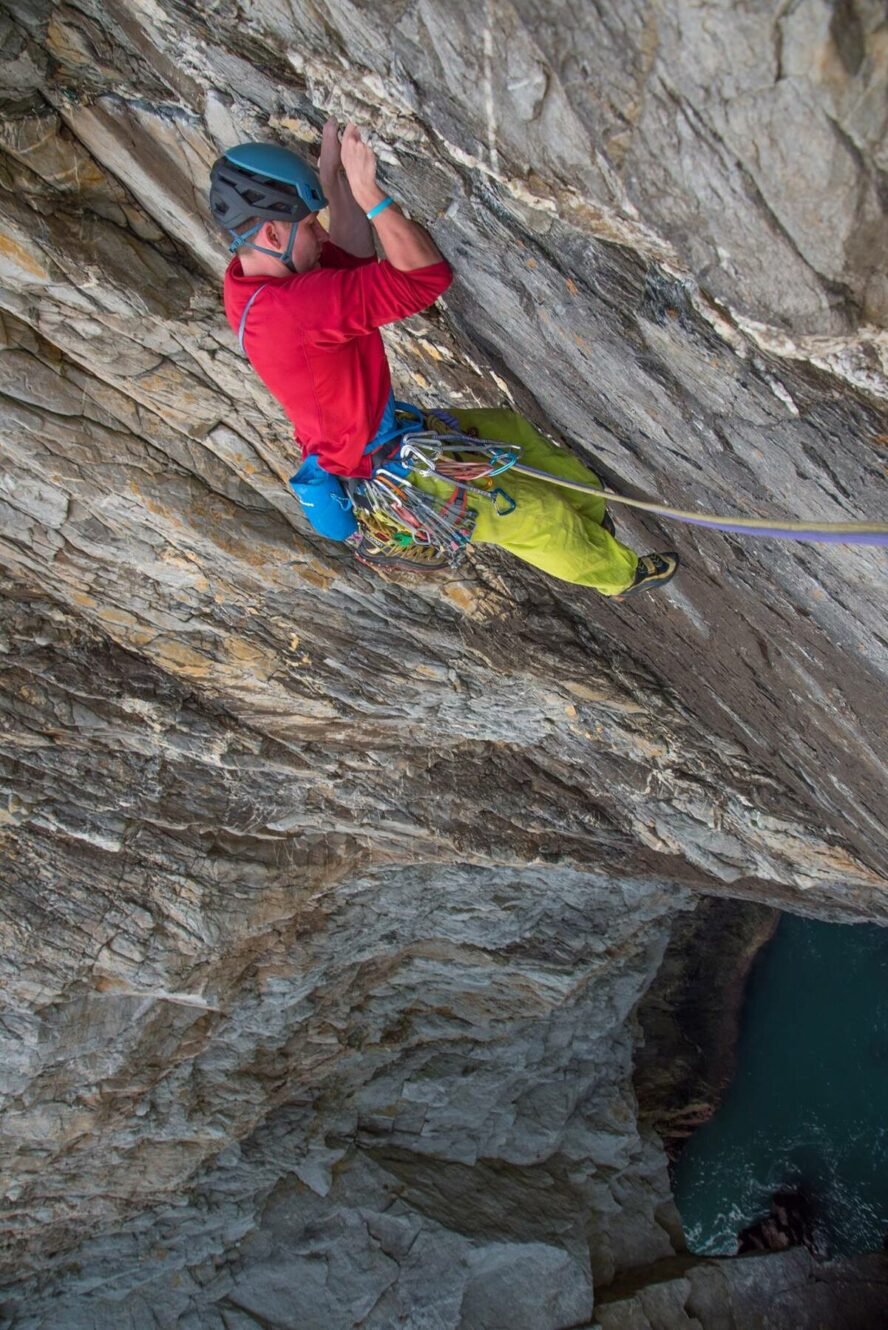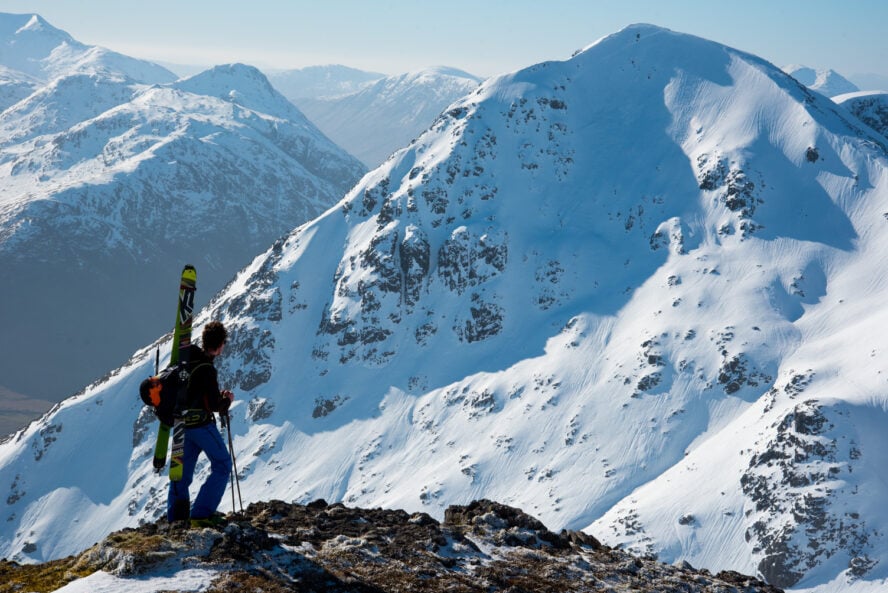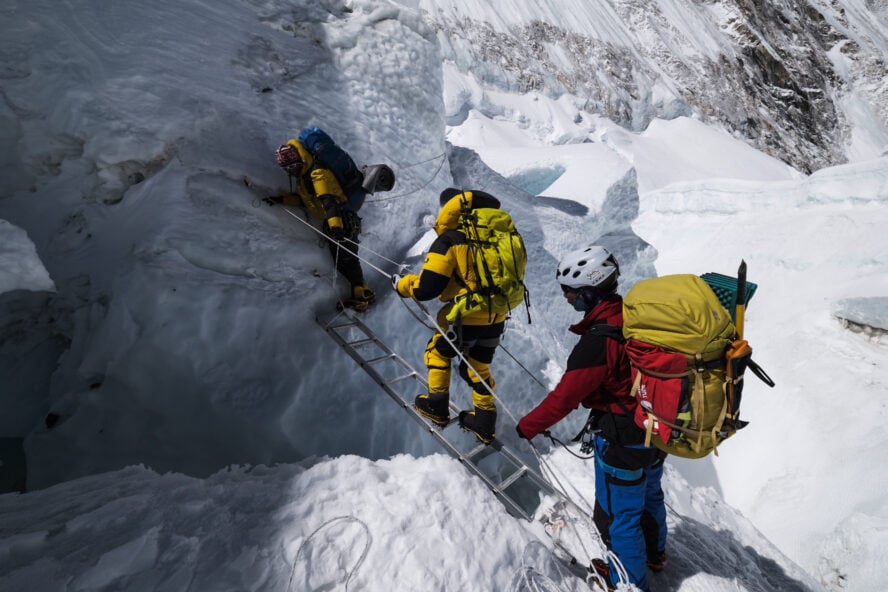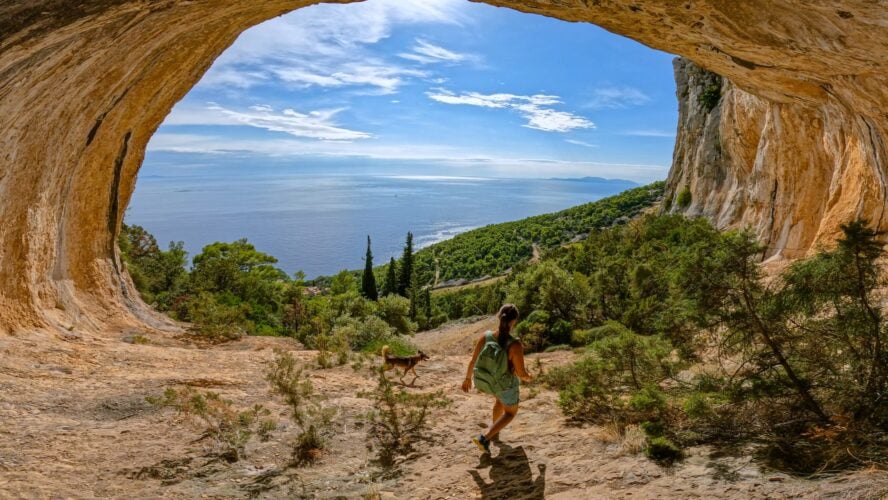“Dude, I really dont think whatever we just did is on route!”
“I know, man!,” Matt retorts back at me.
I’d run out of rope searching around on an indistinct slab and eventually settled on a marginal belay to bring Matt up. Above me, he’d led a tenuous and poorly protected pitch of 5.10 ending up in a small alcove, the walls of which were lined with kitty litter.
This was supposed to be 5.6, or something easy, and as I pull over the final mantle into the horrifically grotty little scoop in which he is now sitting, my eyes are wide with fear.
Where the hell were we?
The long silhouettes of stiletto peaks, cast by a bright-yet-setting autumnal sun, foreshadow the inevitable: we were going to be spending the night lost up high, on what was for us a massive alpine peak in British Columbia’s Coast Mountains.

Fun and thrilling for what?
I’ve had plenty of time since that night to reflect upon why we were even caught up there in the first place. Across my now nearly decade-and-a-half of living a semi-dirtbag lifestyle—full of travel, climbing, adventure, and escapism (none of which I’ve done particularly well, I might add)—I have always been perplexed by risky forms of leisure.
This is, afterall, supposed to be fun, right? Yet there we were increasing our exposure to physical suffering, and possibly even death. Why?
Why Do We Adventure?
How and why Matt and I even chose that objective in the first place is something difficult to put into words, as climbing challenges often are. This is likely because our knowledge, love and joy of climbing is first and foremost a feeling and by nature feelings are very difficult to describe.
Emotions, words and concepts generally do a very poor job of painting the complex picture of our internal worlds as our internal worlds are often incredibly personal and nuanced.
There is a great deal of recent research to suggest that outdoor athletes who veer towards the more risk-positive end of the spectrum can be described as alexithymic—people who have difficulty experiencing or expressing emotion.
These athletes gravitate towards scenarios of prolonged engagements that provide access to emotional states they don’t normally experience or where upon exiting from such scenarios they have enduring increased arousal.

In the context of climbing, being connected to a wall solely through tiny edges and smears in exposed terrain can make one feel exceptionally precarious eliciting our body’s autonomic fight-or-flight responses: increased blood supply to the brain, muscles and limbs; a faster heart rate; muscle tension; increased adrenaline.
Finally, we lapse into a heightened state of awareness that is primarily instinctual—we think less and become more reactive. The immediacy of these experiences can make, by contrast, our worlds at home seem dull, as if they are part of a play that we are nonetheless obligated towards.
I knew there was no going back
I’d seen images of our objective in guidebooks and magazines—a remote, giant, prehistoric mohawk—and instantly felt fiery surges of “stoke”. The aesthetics of the line and the geometry of the mountain promised exposure; it also promised a difficult, dangerous and complex retreat.
On the line itself, it became increasingly obvious to us the further we went… up was the only option.
This is part of the reason I love alpinism: the heightened state of awareness climbers get on such big faces lasts for hours. The feeling of being completely in-tune with your body and your surroundings is exceptionally compelling.
I know that I feel drawn to this due to my own relationship with risk positivity. As a self-diagnosed, alexithymic person I’ve found that my own joy, pain, passion, excitement, suffering, thrill, etc., have often been inaccessible to me without a severely heightened state of arousal.
So while the line itself was compelling and stunning, the commitment of the objective, the demanding nature of its “no-going-backness” was arguably what drew us to it the most.
I’ve found that my own joy, pain, passion, excitement, suffering, thrill… have often been inaccessible to me without a severely heightened state of arousal.
Some may challenge the idea that risk taking is a central notion in outdoor sports, but for me it is one of the most crucial aspects.
Above all, we were there to take risks, to feel and experience the fear and other emotions which can only be accessed through heightened states of arousal and which are only ascertainable if there exists a sense of uncertainty and consequence. We were there to explore the “edge” of our emotional, psychological, and physical limits.
Risk-Taking Is a Central Part of the Outdoor Experience
Sociologist Stephen Lyng’s, theory of “edgework”, describes how participants plunge themselves into experiences of chaos in order to manifest feelings and sensation of control over risk and uncertainty (both of which are generally underpinned by death-related anxieties).
A great deal of voluntary risk-taking behaviour research tends back this up: risk-takers gravitate towards such behaviour to assert a command over vague, inchoate, internalized, and ever present feelings of low-level anxiety, which at its core is of death.
The research suggests that risk-positive sports tend to help athletes emotionally. This is because whilst experiencing fear one learns how to work with it to continue functioning. Thus, control during chaos becomes a central premise of risk-taking.
8,000 metres up: What are you so anxious about?
In my own PhD, which explores tourism in the “death zone” on the world’s 8,000 metre peaks, one thing I ask to my interview participants is: are they anxious, and if so, what exactly are they anxious about?
I found similarities between mine and other research that suggest the somewhat controlled experiences of risk taking in outdoor sports—the symbolic act—helps participants to function in “normal life”.
Engagements with risky situations manifest a gamut of emotions and anxieties. Through prolonged suffering, discomfort, and constant anxiety on high-altitude peaks, these participants brush up against long-held fears, traumas, and anxieties which have been present their entire lives. Narratives like, “you’ve always been a quitter” or “you’re not good enough”, constantly came up.
What is interesting was the way in which hard, arduous, and risky undertakings were viewed as transformative—they help participants feel more secure in their daily lives because of how risk-taking has helped them to feel more emotionally durable.
0,000 metres up: What are you so anxious about?
Maybe you’re thinking, “so what?” or “who cares?” Perhaps the ideas of edgework don’t actually matter to the everyday climber (or trail runner, surfer, mountain biker, you name it).
Perhaps confrontations with risk and fear just aren’t central parts of the outdoor sporting experience for the average participant, after all our sports are becoming increasingly safer, more accessible, and controlled (think the difference between trad and sport climbing, for example).

Well, anyone who has ever signed up to run their first 5k, or 100 miler, knows it’s pretty darn frightening. And the mere presence of “self-help” books on managing one’s fear and emotions, such as the Rock Warrior’s Way or The Vertical Mind, and fear management camps for climbers, suggest that facing fear and risk, in-and-through outdoor sports, is an important element of the experience and one which participants want to become more adept.
It suggests that doing our sports isn’t about being fearless, but about chucking the middle finger up at fear, anxiety, and uncertainty; and growing, through voluntarily scaring the bejesus out of oneself. We can live with these emotions and learn to function despite them.
Feel the fear and bloody doing it anyways!
You Could Die Crossing the Street
Many outdoor enthusiasts have histories of near misses, and given the inherent risks of our sports, most of us have well rehearsed rationalizations about why we do it, or continue to do them.
In a way, these “at-the-ready” narratives—yeah, but you could die crossing the street—are partly a defense against the questions of others who may not entirely “get it” but they also reveal the inner workings of the mind: we are conscious of, and consistently remind ourselves of the ways in which life in modern society, despite illusions of safety, is pretty darn risky.

What this also suggests is that our community is uncomfortable with the chance of funneling towards a meaningless death, i.e., choking on a hot dog. Or in other words, we pursue our sports because it puts us in contact with death—a risk of our choosing—as opposed to ignoring the inherent danger veiled in the safety of the day-to-day.
So close you can touch it
My own research with climbers tends to suggest that end-of-life thoughts are more prevalent among climbers who seek to maximalize their sense of liveliness.
They do this through a constant search of experiences that put them directly into contact with risk, fear, and death in a very unambiguous way. For them, death isn’t something far away, it’s right bloody there. As one of my participants said it’s “so close you can touch it”.
Studies have shown that those who have a greater sense of purpose and meaning in their lives are happier, more motivated, and productive individuals. Being concerned with having a meaningful existence is ultimately an acceptance of the absurdity of life, that existence has little in the way of a point other than that which you make for yourself.
Speaking purely for myself, the thing which keeps me going each year is the growing list of adventures and expeditions that help me to feel present and grounded. In this way, projects, goals, and aspirations that we have in outdoor sports place us into situations and moments of meaning; even though they may be dangerous, even though they could (on a really bad day) cost us our lives or able-bodiedness, we nonetheless accept the risks of our projects.
In essence, we are facing down some of the most fundamental existential questions through engagements with risk in outdoor sports.
Freedom at the Edge
Most of my interview participants agreed in one way or another, that the view from the “edge” is freeing.
Their perspectives of life as seen from the “edge” makes a great deal of what we experience as humans seem trivial. During my time spent interviewing climbers at Mount Everest and K2 basecamps, I eventually began gravitating towards questions like, “what have you learned about yourself from all this?” This is partly due to the suspicion that hard, arduous, and risky experiences help many people in various ways.
One of my participants brought up, multiple times, the example of responsibility that comes with high-altitude mountaineering.
“I don’t hold back, I say the things which need to be said in case I never get to say them”.
“If I am high on the mountain, and there is a storm coming, if I don’t get up and walk myself down to basecamp, well I’m gonna die up there”. Going back into “normal life”, she, and others, described a deeper sense of authenticity because, as she would later tell me, “I don’t hold back, I say the things which need to be said in case I never get to say them.”

Voluntary risk-taking behaviour is ultimately about living with death and developing the tools and emotional competencies to wield upon its anxiety-inducing presence. If someone were to simply ask me why we all do it, for me it’s the easiest answer ever: because it makes us feel more alive.
Why exactly this is the case is the better question
For most, the pursuit of technical challenges that are at the very edge of our abilities can induce a feeling of escape, immersion, control and flow. These moments alone make us feel more alive for how demanding they are, ultimately freeing us from being consumed with daily life and its normal course of worries.
As I have shown through the above example, it also makes some of my participants feel more alive because it helps them to see their normal life problems as less threatening when compared to the truly serious moments they have experienced on 8000ers.
For many others, our sports make us feel more alive because we build physical and emotional competencies which help us to be grittier and more resolved in the face of life’s complications.
Many climbers experience a constant “low-level anxiety” caused by a “precarity consciousness” which tends to create an ever present awareness of death. This constant presence ultimately means that, as people who contemplate death more often, we become more concerned with building meaning in our lives.
If someone were to simply ask me why we all do it, for me it’s the easiest answer ever: “because it makes us feel more alive.”
The view from the edge is freeing for two reasons: 1) experiences at the edge are so demanding and all-consuming they become “peak experiences” in our lives, hence filling them with meaning; 2) We feel a sense of ontological security based on the knowledge of ourselves as capable individuals. This is because the experience, and the mountains, “shows us to ourselves”.
The Experience as a Mirror
Matt and I reached the summit right with the light officially leaving us. I tried to lead a scrambly pitch across the jagged summit crown to begin searching for the descent, but my legs were shaky standing on the sharp protruding ridge, pure blackness shooting down below me on either side.
“Mate, I’m done, I can’t,” I must have said. And now Matt and I had to debate a new and pressing matter: big spoon or little spoon?
In the morning we rose to one of the most spectacular inversions I’ve ever seen; the sun glinting off little islands in the sky, distant glaciers, and pointy black towers of the Coast Mountains. It is moments of splendor like this when things feel pretty obvious, the why we do this, that is.
Yet part of me also feels that I didn’t see that sunrise in a wholly honest way. The scene was beautiful, sure, but the sunrise that morning was tainted by a sense of relief; it was a confirmation that we’d come out the other side. The juxtaposition between the previous night’s suffering made the following morning all the more surreal.

I am a mountain
I suppose in a way I am like my research participants. I have my own skeletons in the closet which poke their heads out and cause chaos from time to time: “you’re not good enough”, “you’ve never tried hard enough”, the list goes on. On the bad days they can ruin everything. When I feel strong they are nothing at all.
Being high on a peak, immersed in true struggle has always helped me; the experience is like a mirror which tells us a little bit about who we are in the face of danger—and in daily life. In the end, it’s not just anxieties about death which drive us into confrontations with risk, but also about silencing our inner narratives. Sadly, the truth is that most often we are the ones who pose the greatest risks to ourselves.
I have learned a great deal about who and what I am amongst the high and hostile places of the world, or rather, those places have participated in shaping me into a person that I like more than I could really have thought was possible as a younger man.
It has taken many years, but the ongoing results are that I feel more anchored and grounded despite the imposing, impossible, bewilderingly overwhelming scenes of life and all its choices, uncertainties, and responsibilities. When I was younger, life felt like a speeding car twisting out of my control; that sense caused me to avoid taking on responsibilities because I lacked trust in myself.
Lessons from the edge
Today, I know that whatever I have achieved can be directly attributed to what I’ve learned about myself in the mountains. I have taken on challenges in other areas of my life which I definitely would have avoided otherwise, and arguably, as a result, I would have been a much less fulfilled person.
For me, the view from the edge has been the most compelling for how our sense of self grows. Taking risks can expand the space we have to exist in, in this way we are not just more secure and free from death-related anxieties in our day-to-day, but that freedom has a futurity to it; a lasting, ongoing effect that helps us to orient our future goals.
Mountains have undoubtedly made my life better for how they have convinced me that better living is possible; they have shown me that it is possible to feel afraid and still do it anyways not just in climbing, but in all walks of life.
But it is only at the “edge” where the value lies, and the learning occurs. Pull up short and quite often it does not have the same effect, push too far and…
Why does voluntary risk-taking—adventure—make us feel more alive? Because it helps us to build confidence in a world that we suspect may have unfriendly situations or moments in store for us. In the end, risk-taking can be viewed as healthy and beneficial to one’s life; it may even reward us to take more risks.





